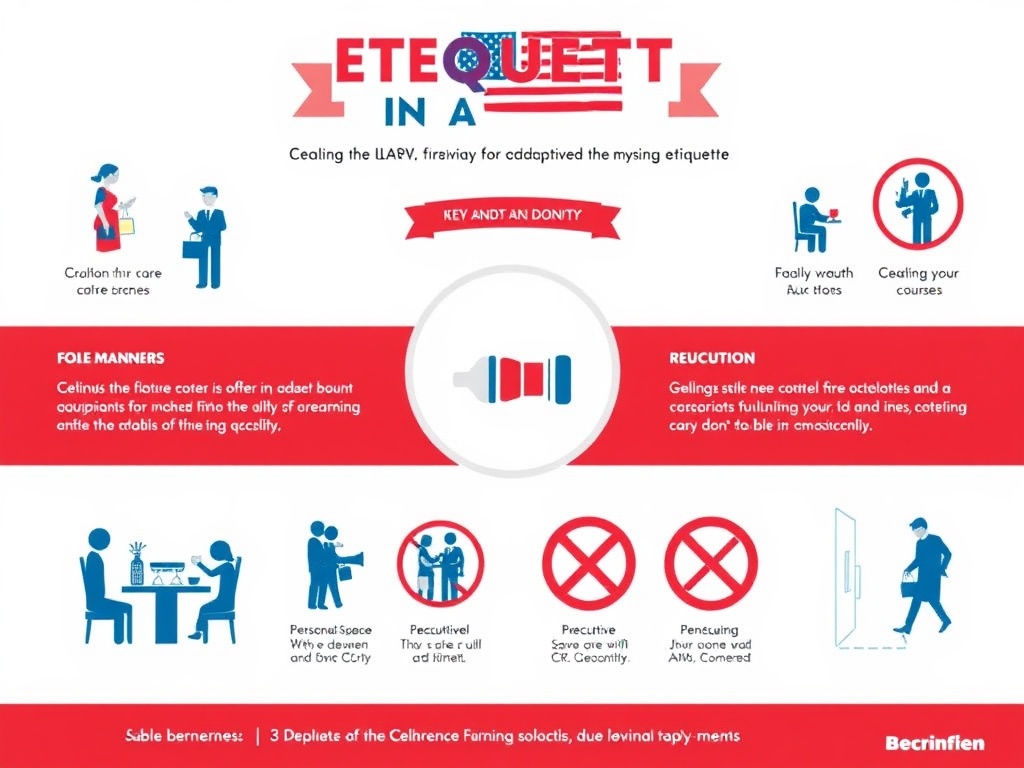Mastering the Art of Greetings: Key Cultural Practices in the USA

The Power of a Smile
In the United States, a warm smile can open doors and create immediate connections. When meeting someone for the first time, a genuine smile not only conveys friendliness but also sets a positive tone for the interaction to follow. It’s an integral part of American culture and should not be underestimated.
When greeting someone, consider the context and the relationship you have with the person. A smile can make your greeting feel more personal and engaging.
Handshakes: The Universal Gesture
In professional settings and formal situations, a firm handshake is the standard greeting in the USA. This gesture signifies confidence and respect. However, the nuances can vary based on the region, gender, and cultural background of the individuals involved.
For instance, while a firm handshake is generally expected in business contexts, in more casual settings, you might encounter a friendly hug or a simple wave.
- When to Shake Hands: At business meetings, networking events, or when introduced to someone for the first time.
- When to Avoid Handshakes: In more casual or intimate settings, or when you sense that personal space is preferred.
The Importance of Names
In American culture, using someone’s name during conversation is a sign of respect and attentiveness. This practice fosters a feeling of connection and can enhance the relationship between individuals. Addressing someone by their first name can create a more relaxed atmosphere, but it’s essential to gauge the other person’s comfort level with informality.
Moreover, in professional settings, it is often best to start with a title and last name until invited to use a first name. This approach shows professionalism and respect for hierarchy.
Dining Etiquette: Navigating the Table Manners of American Culture

Dining in the United States can be an enriching experience filled with diverse cuisines and unique customs. However, understanding the nuances of table manners is crucial for making a good impression. This section delves into the essential dining etiquette that will help you navigate meals with confidence, whether you’re at a casual gathering or a formal dinner.
The Art of Table Setting
When it comes to dining in America, the arrangement of the table plays a significant role. Understanding what each item represents can ease your dining experience and show respect for your hosts.
- Plates: The main plate is typically placed in the center, with side plates for bread or salads on the left.
- Cutlery: Forks are on the left, knives on the right, with the dessert spoon or fork above the plate.
- Glassware: Water glasses are placed above the knife, with wine glasses to the right, depending on the type of beverage served.
Familiarizing yourself with these placements can enhance your dining experience and ensure you use the correct utensils.
Dining Rituals: What to Do and What to Avoid
Once seated at the table, adhering to certain dining rituals can significantly impact the impression you leave. Here are some key do’s and don’ts:
| Do’s | Don’ts |
|---|---|
| Engage in light conversation. | Discuss controversial topics such as politics or religion. |
| Keep elbows off the table while eating. | Point or gesture with utensils. |
| Chew with your mouth closed. | Talk with your mouth full. |
| Wait for everyone to be served before starting to eat. | Start eating immediately without acknowledging your hosts. |
Observing these guidelines will demonstrate your respect for the dining experience and your fellow diners.
Expressing Gratitude: The Final Touch
After the meal, expressing appreciation is not just polite; it is expected. A simple ‘thank you’ to your host can go a long way. If dining in a restaurant, tipping is customary, typically around 15-20% of the total bill, reflecting your satisfaction with the service. This gesture is an integral part of American dining culture and reinforces positive relationships.
Understanding Personal Space: The Unwritten Rules of Proximity
In American culture, personal space is a significant aspect of social interactions. Understanding how close to stand when speaking to someone can impact the comfort level of both parties. This unwritten rule often varies with different contexts, relationships, and individuals. Therefore, navigating personal space is essential for fostering positive interactions.
The Importance of Personal Space
Personal space refers to the physical distance individuals prefer to maintain from others during interactions. In the United States, the typical personal space zone ranges from 1.5 to 3 feet in social settings. Respecting this boundary is crucial, as invading someone’s personal space can lead to feelings of discomfort or anxiety. It is important to observe cues from those around you to gauge their comfort levels.
Contexts That Influence Proximity
Different scenarios dictate varying degrees of personal space. Understanding these contexts can help you navigate social situations more effectively. Below are some common contexts and how they influence personal space:
| Context | Typical Proximity | Notes |
|---|---|---|
| Casual Gatherings | 1.5 – 2.5 feet | Friendly interactions with acquaintances or new friends. |
| Professional Settings | 2 – 3 feet | Maintain a respectful distance, especially with superiors. |
| Intimate Relationships | Less than 1.5 feet | Closer proximity is comfortable and often welcomed. |
| Public Spaces | 3 feet or more | People tend to keep more distance in crowded areas. |
Personal Space Cues: Reading the Room
Being aware of personal space cues is vital for successful interactions. Here are some signs to look out for:
- Body Language: Pay attention to how others position themselves. Leaning away or crossing arms may indicate a desire for more space.
- Facial Expressions: A frown or lack of eye contact can signal discomfort.
- Verbal Cues: If someone steps back while speaking, it’s a clear indication to respect their personal space.
By honing your ability to read these cues, you can create a more comfortable environment for both yourself and others, ensuring that interactions are pleasant and respectful.
The Power of Small Talk: Engaging in Everyday Conversations
Embracing the Art of Small Talk
In the fast-paced world of American culture, small talk serves as a vital social tool, bridging gaps between strangers and establishing connections. This seemingly trivial form of conversation can lead to significant relationships, whether in personal or professional contexts. Understanding the nuances of small talk can enhance your interactions and make you a more engaging conversationalist.
Topics That Spark Interest
When engaging in small talk, choosing the right topics is essential. Opting for universally relatable subjects can foster a comfortable environment for dialogue. Here are some popular themes often embraced in casual conversations:
- Weather: A classic opener that everyone can relate to.
- Local Events: Discussing nearby happenings can create a sense of community.
- Hobbies & Interests: Sharing personal passions can lead to deeper connections.
- Travel Experiences: People love to share stories about their adventures.
Mastering the Flow of Conversation
As you navigate small talk, it’s crucial to be aware of the dynamics at play. Listening actively and showing genuine interest can significantly enhance the interaction. Here are some key practices to refine your small talk skills:
- Ask Open-Ended Questions: Encourage the other person to elaborate on their thoughts and experiences.
- Be Mindful of Body Language: Maintain eye contact and use positive gestures to convey engagement.
- Share Personal Anecdotes: Relating your experiences can make the conversation feel reciprocal and engaging.
By incorporating these practices into your small talk repertoire, you can create a welcoming atmosphere that invites further conversation.
Gift-Giving Etiquette: What to Know Before You Present
Gift-giving in the United States is not merely a formality; it is an expression of thoughtfulness and appreciation. Understanding the nuances of this practice can significantly enhance relationships, whether they are personal or professional. The act of presenting a gift conveys respect and consideration, but ensuring that your gift aligns with cultural expectations is equally important. This guide will help you navigate the essential aspects of gift-giving etiquette in American culture, allowing you to make lasting impressions.
Understanding the Occasion: Gifts for Every Event
In American culture, different occasions call for different types of gifts. Recognizing the significance of the event is crucial for selecting the right token of appreciation. For example, birthdays typically warrant more personalized gifts, such as books, clothing, or gadgets that reflect the recipient’s interests. On the other hand, weddings often require gifts from registries, showcasing practicality and thoughtfulness.
Holidays such as Christmas or Thanksgiving emphasize shared experiences, so consider offering items that can be enjoyed collectively, like gourmet food baskets or festive decorations. Moreover, don’t overlook the importance of showing appreciation to colleagues during work-related events; thoughtful tokens like coffee mugs or small desk plants can foster a positive workplace atmosphere.
Presentation Matters: The Art of Wrapping and Timing
How a gift is presented can be as essential as the gift itself. Americans value aesthetics, and a well-wrapped gift can heighten the excitement of the unwrapping experience. Use quality wrapping paper and consider incorporating ribbons or bows to add a special touch. Additionally, a handwritten card expressing your sentiments can elevate the gesture, emphasizing the thought behind the gift.
Timing also plays a critical role in gift-giving. Ensure that gifts are presented at the appropriate moment, such as bringing them during a party or celebration rather than sending them beforehand. This not only allows the recipient to enjoy the moment but also creates a shared experience that can strengthen bonds.
What to Avoid: Navigating Cultural Sensitivities
While gift-giving can be a delightful practice, being aware of what to avoid is equally important. Gifts that may be perceived as too personal or extravagant can make recipients uncomfortable. For instance, items like perfume or clothing can be tricky, as preferences may vary significantly. Additionally, be cautious with gifts that could be perceived as culturally sensitive, such as alcohol or religious items, especially if you are unsure of the recipient’s beliefs.
Moreover, avoid gifts that could be interpreted as overly expensive in professional settings, as this may create an imbalance in relationships. Instead, focus on thoughtful, universally appreciated items that reflect your understanding of the person and the occasion.
Dress Codes Decoded: Dressing Right for Every Occasion
In American culture, the way you dress speaks volumes about who you are and how you regard the event or gathering you’re attending. Understanding the various dress codes can help you make a strong impression while respecting the traditions and expectations of those around you. Whether you’re attending a formal wedding, a corporate meeting, or a casual get-together, knowing what to wear can enhance your confidence and ensure you fit in seamlessly.
Understanding Formal Attire: When Elegance is Key
Formal occasions in the United States often require a specific dress code, and it’s essential to understand the nuances involved. Whether it’s a black-tie event or a formal wedding, adhering to these guidelines demonstrates respect for the event and its hosts.
- Black Tie: A tuxedo for men and an evening gown for women are standard. Accessories should be elegant but understated.
- Formal Attire: Men may wear a suit and tie, while women can opt for a cocktail dress or a sophisticated outfit.
Business Casual: The Balancing Act
In professional settings, business casual has become increasingly popular, offering a blend of professionalism and comfort. However, the interpretation of business casual can vary widely among industries, making it crucial to gauge the expectations of your workplace.
Key Elements of Business Casual:
- Men: Collared shirts, dress pants, and loafers are ideal. Ties can be optional based on the company culture.
- Women: Blouses, dress pants, or skirts are suitable. Closed-toe shoes often complete the look.
Casual Gatherings: Embracing Comfort and Style
Casual settings allow for the most flexibility in attire, but that doesn’t mean you can overlook style. Dressing appropriately for casual gatherings can still reflect your personality while maintaining a sense of respect for the occasion.
Outfit Ideas for Casual Events:
- Opt for well-fitted jeans or chinos paired with a stylish top.
- Choose comfortable yet trendy footwear, like loafers or stylish sneakers.
- Accessorize with simple jewelry or a nice watch to elevate your look.
In summary, understanding and adhering to the appropriate dress codes in various social contexts is vital in American culture. By dressing appropriately, you demonstrate respect for the occasion and the individuals involved, making a favorable impression that extends beyond mere appearance.
Respecting Diversity: Embracing Cultural Sensitivity in America
In a nation as diverse as the United States, understanding and respecting cultural differences is paramount. The rich tapestry of cultures, ethnicities, and traditions contributes to the nation’s identity, making cultural sensitivity not just a nicety but a necessity. Navigating social interactions with an awareness of varying backgrounds can foster inclusivity and strengthen communal bonds.
Understanding Cultural Nuances
Each culture possesses its own set of values, customs, and communication styles. Recognizing these differences is vital when engaging with individuals from varied backgrounds. Here are a few cultural aspects to keep in mind:
- Communication Styles: Some cultures prioritize direct communication, while others may favor a more indirect approach. Pay attention to how others express their thoughts and adapt your communication accordingly.
- Body Language: Gestures, eye contact, and even physical touch can convey different meanings across cultures. For example, while a firm handshake may signify confidence in American culture, it might be perceived differently in other societies.
- Traditions and Celebrations: Familiarize yourself with important holidays and customs that hold significance to different cultures. This knowledge can lead to deeper connections and show respect for diverse backgrounds.
Practicing Empathy and Open-Mindedness
Embracing cultural sensitivity begins with empathy. Put yourself in others’ shoes and consider their experiences and perspectives. Here are some steps to cultivate an open-minded approach:
- Listen Actively: Engage in conversations with genuine curiosity and an open heart. Listen to understand, not just to respond.
- Ask Questions: If you’re unsure about a cultural practice or belief, don’t hesitate to ask respectfully. Most people appreciate the interest in their background.
- Acknowledge Differences: Recognize that diversity enriches experiences. Embracing differences can lead to more meaningful interactions.
By fostering an atmosphere of respect and understanding, we can create spaces where everyone feels valued and included. In a multicultural society, cultural sensitivity is an invaluable asset that enhances both personal and professional relationships.



